How to treat rotting at home?
To help an exotic plant and choose the right treatment, you should first determine the cause of rot, and only then use this or that remedy.
Chemical
If it turns out that pests (whiteflies, midges, scale insects, thrips) or viral diseases are the cause of root decay, then acaricide or insecticide preparations are useful, such as:
- Aktara;
- "Tsvetofos";
- "Fufan";
- Inta-vir;
- Vermitek.
With fungal infections, fungicides are indispensable. The drugs that are most effective for prevention and treatment are considered fungicides, which destroy the causative agents of fungal diseases in representatives of the flora. They are of different spectrum of action. The main active substances of fungicides are: aldehydes, mercury, copper, manganese, organic substances.
- Oxyhom;
- Fundazol;
- "Immunotitofit";
- Fitosporin;
- "Topas".
Folk
What can you do at home to save rotting roots? Homemade recipes are proven over the years. Yes, they do not have the same degree of damage as industrial ones, but they are more affordable and environmentally friendly.
- A decoction of cyclamen tubers. For cooking, you will need finely chopped flower tubers. It is advised to boil them over low heat for 30-40 minutes. Leave for a day. After the broth, strain, and lower the diseased roots of the orchid into it for 5-10 minutes.
- Soap solution. Dissolve 1 bar of laundry soap in 3 liters of clean warm water. Then immerse the roots in soapy water for a few minutes.
- Oil solution. Dissolve 2 tablespoons of olive oil in 1 liter of water. Orchid roots can be immersed in the resulting mixture.
- Onion infusion. Cook 3-4 small onions for 30 minutes. Then cool the broth and leave for a day. The pure roots of the flower should be left in the healing liquid for 7-10 minutes.
Important. Folk remedies can only help in the early stages of the disease.
What to do to keep the foliage from disappearing?
If the florist notices that the leaves of the plant are beginning to rot, you should immediately take measures to save it:
- Place the flower in another room to isolate it from healthy plants.
- Trim off any damaged leaves. In this case, the instruments must be calcined or treated with an antiseptic. The resulting cut on the trunk is also disinfected using activated charcoal or an alcohol-free antiseptic.
- After removing the damaged leaf part, a fungicide is applied.
- It is imperative to treat the window frame and the window sill on which the sick orchid stood.
- If possible, the flower is transplanted into another pot, and the old one is soaked for four hours in soapy water.
- After processing, it is recommended not to moisten the soil for a week.
- Be sure to look at the wounds that have formed at the time insects appear in them and every day treat them with charcoal, cinnamon or an antiseptic, but only without alcohol.
Attention! All leaves should be trimmed to a green cloth to avoid getting rot in the heart of the flower. If the rot is inside the core, it should be removed, the plant can live without it, it will just take a little longer to recover.
The main methods of resuscitation if it dries up:
By the time the whole plant dries up, it will exhaust its plastic substances, it will be impossible to save it. However, if the plant has dried up only partially and there are living areas, then it is still possible to restore it:
- Before resuscitating a dried orchid, remove the plant from the pot and inspect;
- All dry, rotten and dead plant parts should be removed;
- After treating the sections with antiseptics, spray the plant with zircon and place it in the greenhouse on a pillow made of wet (not wet!) Sphagnum and expanded clay;
- After two days, treat the orchid with epin;
- If no roots remain, heteroauxin can be used.
In general, resuscitation of a dried orchid, in fact, is not much different from that if the plant rotted.
The whole plant, but the roots are green
Since the roots and foliage are part of one plant and do not live on their own, the assessment of the viability of the orchid and the decision on further actions must be carried out according to the general condition of the plant. So, living roots are not yet a sign that it will survive. However, you can try to revive the plant in a mini greenhouse.
Important! Since the plant has no leaves left, it will have nothing to evaporate moisture. Rooting will only worsen the situation.
Remove any dry areas, spray the roots with stimulants and place what is left in a mini greenhouse.
Stem
If the stem began to dry, then, obviously, the cause of drying is in the roots. Since the orchid stores moisture in terrestrial organs (leaves or pseudobulbs), the fact that the roots have dried / rotted may not immediately become apparent. It often happens that green tops with more or less normal turgor are sitting in a pot already without roots.
In order to revive the plant, it is pulled out of the pot, all the dead areas of the roots are cut off and sent to intensive care or transplanted. Leaving is normalized.
Orchid with a dried stem.
Growth point
For a sympodial orchid, this is not scary. For monopodial, it means that the plant will stop growing. Sooner or later, after the leaves grow old and dry, she will die. And before that, the orchid needs to be helped to reproduce itself, that is, to give offspring - a baby. Shoots, as a rule, in this case appear on the side of the plant or at the roots.
Sheet mass
It is necessary to determine the cause of the drying and correct the error. Usually, after correcting all the shortcomings in the care and normalizing the growth conditions, the plant itself recovers.
Root
- If almost all the roots have dried up, then the orchid is sent to intensive care according to the general scenario;
- In case of partial loss, the plant is transplanted into a smaller pot, care and watering are normalized;
- Use stimulants such as heteroauxin for more confident root growth.
Dried orchid roots.
Attention! The main task is to grow roots to the depletion of plastic substances (before the leaves / pseudobulbs dry out). If everything is done correctly, the orchid will calmly build up and restore them .. The loss of even the entire root system does not mean death for the orchid.
You just need to determine the cause in time and correct the errors.
The loss of even the entire root system does not mean death for an orchid. You just need to determine the cause in time and correct the errors.
Peduncle
Drying the stem of an orchid is normal after flowering is complete. Not all types of peduncles are perennial. Therefore, when it dries completely, it must be removed. If only the top of the peduncle has dried up, then it is partially cut, 2 cm above the dormant bud.
How to save an orchid that has rotted:
Roots
It is very important to start the resuscitation process as early as possible, this will increase the chances of saving the orchid. In order to choose the optimal recovery method, it is necessary to carefully examine the roots and determine the degree of their damage:
- Green color indicates a young root system, they will differ in elasticity and density;
-
The main sign of the onset of decay is the darkening of the roots, the appearance of mucus or moisture on them when pressed.
In the presence of decayed areas, they must be:
- Remove carefully to stop the spreading process to healthy roots;
- Then the leftovers must be sprinkled with activated charcoal or cinnamon;
- After the remnants of the roots are completely dry in the air, it is recommended to treat them with special fungicidal agents.
Important! In order to increase the chances of root recovery, it is recommended to feed them with mineral fertilizers.
There are several main ways to resuscitate an orchid:
Using a home greenhouse option. To do this, use a special container that can be built from an ordinary plastic bottle. Expanded clay is placed on the bottom and the dried and disinfected substrate is poured. Next, an orchid is placed there and the following conditions of detention are observed:
Temperature within 22-28C;
Humidity not less than 70%;
Lighting 12-14 hours a day.
Such criteria must be observed until new roots of about 3 cm appear. The duration of the revitalization of the plant depends on the degree of damage to the root system.
Most often, after 2 weeks in such conditions, you can see signs of new roots. If they grow up to 5 cm, then the orchid is transplanted into a regular pot and the usual care is continued;
If the roots of the flower are completely rotted, you can restore them by placing the orchid in a container of water.
It is very important that the leaves remain completely dry. It is necessary to keep the plant in water for at least 6 hours a day.
To speed up the process of nucleation of new roots, a little honey or sugar can be added to the container with liquid.
The term of resuscitation depends on how much the roots have been damaged. In some cases, recovery is possible in a month, while in others it takes more than one year.
Therefore, it is very important to be patient and fulfill all the necessary conditions to save your beloved orchid.
Advice! In a blooming orchid, first of all, it is necessary to establish the degree of damage to the root system. Then choose the appropriate resuscitation method for you: a mini-plaque or placing in a container with water.
Aboveground parts
In this case, it is necessary:
- Remove all decayed areas;
- Dry the orchid well;
-
Treat with an antiseptic and fungicide.
If most of the roots still remain unaffected, then it is recommended to simply transplant the flower into another pot.
In this case, you need to use a fresh substrate that has been well dried and treated with disinfectant solutions. You also need to provide mandatory conditions of detention:
- Temperature up to 25C;
- Humidity not less than 70%;
- And bright light for at least 12 hours a day.
It is important to remember that you need to exclude too strong night changes in temperature and humidity. This will allow the orchid to recover faster and throw out new roots.
Watering is carried out when the substrate is completely dry. This is best done by immersing the pot in a container of water for a short time. After 7-30 days, the emergence of the rudiments of new roots can be observed.
Neck
Is it possible to save an orchid if the neck is rotten? If you observe dropping of orchid leaves, you need to conduct a thorough inspection. A sign of rot is the yellowing of the base of the leaf. In this case, it is quite possible to revive the orchid, for this you need to do the following:
- Remove all decayed areas on the neck;
- After that, carefully treat with activated carbon or Fundazol;
-
Transplant the orchid into a new pot with clean substrate.
It is necessary to take care of the plant as usual. On average, intensive care can take from one to several months.
In this case, it is important to ensure that excess moisture does not get on the neck.
Symptoms of diseases of the root system
Since the orchid is an exotic flower, a tendency to disease often appears in unusual conditions for it. And often the problems of the root system are rotting or drying out of the roots. They rot mainly due to improper moisture: as a result of excessive watering, moisture does not have time to be absorbed and is retained in the pot.If the roots have turned black, this means that they are disappearing and must be pruned urgently.
Under natural conditions, orchids grow in an environment where humidity changes are quite frequent, therefore, in the course of evolution, they have formed enough ways to protect against drying out. Therefore, constant hydration is unnecessary. In addition, periods without watering will intensify the formation of peduncles. During the dormant period, the plant also needs to reduce the intake of moisture.
The roots become dry in two cases:
- lack of moisture;
- a burn with fertilizers with too much saturation or improper selection.

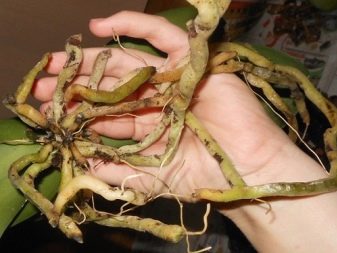
At the first problem, the roots need to be rinsed in water at room temperature and well moistened. In case of burns, the orchid must be transplanted into another soil, less aggressive. The affected parts that cannot be reanimated are removed without fail in both cases. Finding out which roots to cut is pretty easy.
- The rotten ones are yellowish brown, slippery and too flexible. This indicates that they are empty inside, only the shell remains, and they can no longer be restored. Be sure to trim them above the affected area.
- Shrunken ones also become yellow, hard and brittle. You cannot break them off so as not to damage the stems. It is necessary to cut off with a knife or secateurs and process the cuts with chopped charcoal.
The yellow or brown color of the roots does not always indicate their disease. In some cases, they change color due to lack of sunlight or substances that they absorb from the substrate.
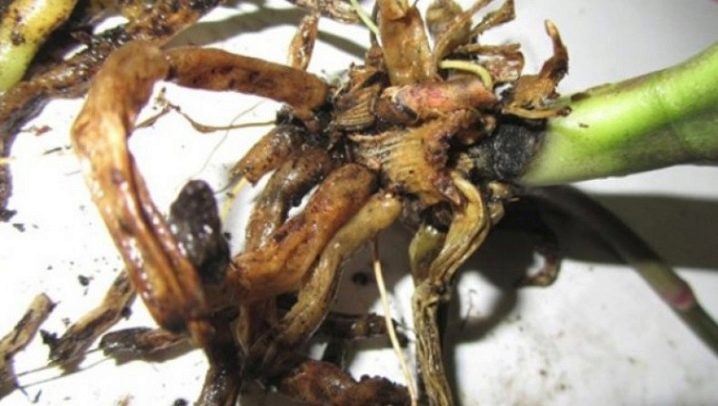
When the root system is overdried, the turgor of the leaves, that is, their normal state, can be restored by soaking the roots. The orchid is removed from the substrate, the roots are washed, immersed in a container of 30–35 ° water and left for a while (no more than 6 hours). You can carry out this procedure for several days in a row, but then the time spent in the water should not exceed 2 hours. Foliar dressing will also help to restore turgor, which is used in the case of severely damaged roots or in case of an urgent need to restore the stem. Liquid nutrients are applied to the surface of the leaves, thereby promoting their renewal.
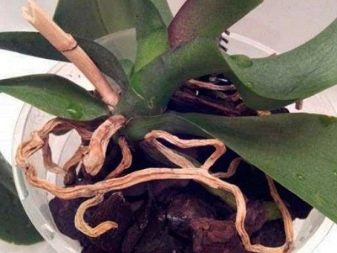
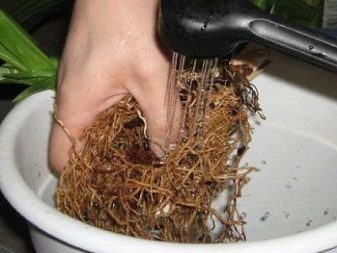
It happens that the leaves and roots of the flower are covered with a white bloom. This is how mold, a fungal disease of plants, manifests itself. It appears from excessive moisture or elevated temperature in the room, as well as when purchasing an already infected flower in a store. Quite often, the roots of a seemingly healthy plant are covered with white dots or balls. Whitish stains of varying sizes can be caused by the hardness of the water. Salts deposited in the soil prevent air from entering the cells of the root system normally, this is manifested by white dots on the roots and in the substrate. Small balls are the mycelium of soil fungi; this form serves as a protective barrier against adverse influences from the outside. When a suitable environment is formed, they grow and cover the roots of the plant and soil with cobwebs, taking nutrients from it.
If you do not take measures against the spread of fungi, over time, the roots of the plant die off. And also, due to unsatisfactory conditions of maintenance, the roots of the orchid may become white. In such cases, the plant is transplanted and in the future, all the rules for the necessary care are observed.
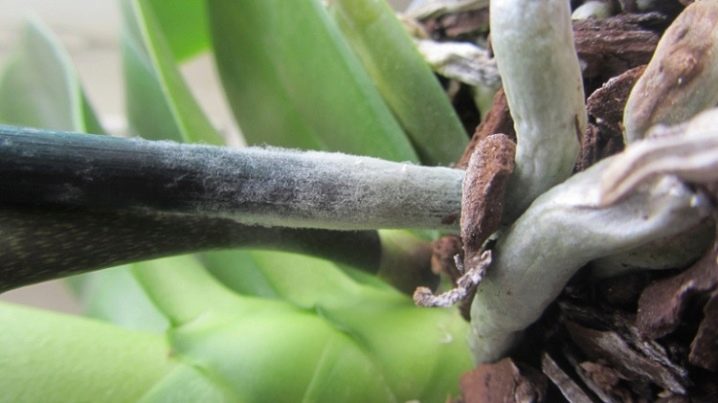
How to properly revive a plant?
How to properly reanimate a plant with rotten, frozen or dried out roots? You can almost always solve a problem, even if the case seems hopeless. It will be possible to correct the situation if the plant was flooded, found frozen (the plant must be allowed to thaw at temperatures below room temperature, and then proceed to resuscitation) or dried. The algorithm is always the same. However, the sooner a problem with the root system is noticed, the greater the chances of successfully reanimating the flower. First you need to inspect the orchid to assess the degree of damage
To do this, you need to pay attention to the roots:
- Healthy roots are fairly fleshy, firm and firm.
- Their color depends on the age of the flower: young ones are light green, old ones are gray or brownish. If the plant has not been watered for a long time, the root system will be almost white, and after watering it will be rich green.
- If the roots are nourishing the plant, they will be smooth, hard, and dry.
It is most convenient to examine the roots by removing the substrate and washing the underground part of the plant. So, rotting will be evidenced by:
- Darkening of the root system.
- When you press the root, liquid will flow.
- The roots are decayed and filamentous.
- There are slimy and weeping areas on the root system.
Rotten and dried roots cannot be saved. They need to be cut with a sharp, disinfected device. You need to trim so as to capture a small part of healthy tissue. Pruning will not affect the viability of the plant, which will be properly cared for in the future.
Next, you need to process the sections with ground cinnamon or crushed activated carbon. Any of these products have disinfectant properties. Then leave the roots to dry. After that, you can immerse the root system in a fungicide solution for about 10-15 minutes to protect the plant from damage by harmful fungi. Healthy areas are treated with growth stimulants to accelerate root growth and promote immunity to disease.
What to do and how to reanimate a flower - step by step instructions
Phytophthora fungus. The most dangerous disease for an orchid. It can kill a plant in just a few days. Having found this fungus, you need to act immediately:
Move away from other pets.
You will need a sharpened knife or scissors. Tools must be disinfected.
The affected areas are removed, up to healthy tissue.
The affected areas are treated with crushed coal.
Wait until the wounds are dry.
Change the land.
The pot and the place on which he stood also to process.
Pythium fungus. Often the infection appears initially on the root system, and then spreads throughout the orchid (why did the roots rot in the orchid and how can the plant be reanimated?). The fight takes place in the same way as with late blight. However, a one-time procedure will not be enough. The processing is repeated several more times. The break is at least 1 week.
Wet bacterial rot. The standard scheme for the destruction of the disease. With bacterial rot, the areas that have been cut are subject to treatment with brilliant green, iodine, since coal is powerless here. The main thing is not to overdo it. The fungicide is selected on the basis of copper. Better to use "Bordeaux liquid". The flower grower should not forget that the plant needs rest between procedures.
Fusarium wilting. A type of fungal infection, distinguished by its vitality. The method of struggle and the sequence are the same, but there is a nuance
When choosing a fungicide, you need to pay attention to the fact that the drug is intended specifically for this disease.
Rotting caused by improper maintenance No need to isolate the orchid. You just need to remove damaged foliage
In the future, it is necessary to analyze and observe the care so as not to repeat mistakes. Any infection spreads rather quickly, so act immediately.
Causes of decay
Diseases in orchids are divided into three groups:
- infectious;
- bacterial;
- viral.
The first two can be dealt with, but if the flower is infected by some virus, then the plant will have to be destroyed. Sometimes even the most experienced flower growers cannot understand these diseases. The most common disease is heart and leaf rot. They start to deteriorate from the base. Such a place becomes wet or various spots begin to appear. In addition, they note:
- weakness;
- the appearance deteriorates;
- turgor is lost;
- growth stops;
- photosynthesis is inhibited.
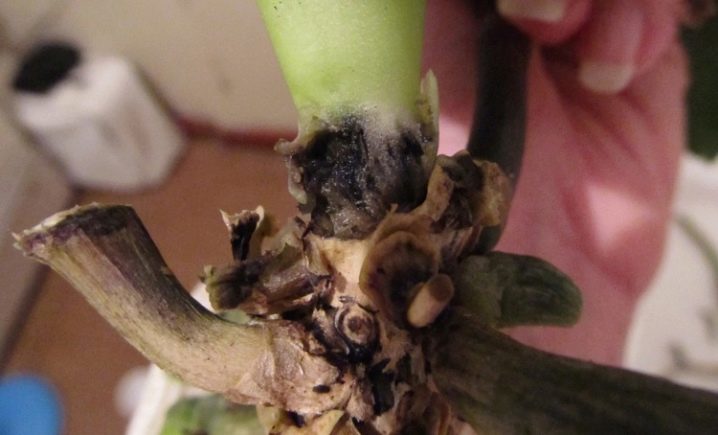
The main thing is a timely noticed deviation and timely correct diagnosis.
It is important to understand why this happened. Here are the reasons why the orchid has rotted:
- care errors;
- bacterial infection;
- very dense soil;
- unsuitable fertilizers.
The solution to the problem of improper care is:
- in revising the irrigation system;
- it is worth raising the temperature;
- insufficient humidity;
- transfer.
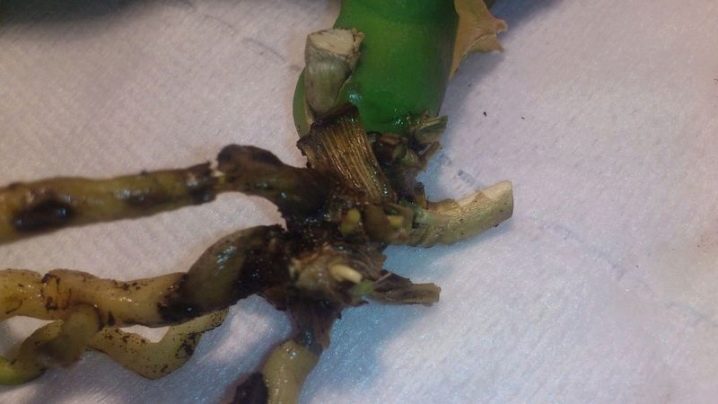
There are many types of rot, it is necessary to carefully examine the plant and understand which of them hit the flower:
- fusarium - leaves become soft, on which a characteristic bloom of pink appears, and after it marks with pink halos;
- pityum - the leaves begin to rot in the middle, turn yellow and fall off;
- late blight - black or dark brown rot appears, then turns into watery areas;
- wet bacterial - the appearance of dark wet spots on the leaves;
- gray - a fungal disease, locally gray fluffy islands appear;
- black - if you keep the plant in a cold room, black spots appear at the base.

The reasons for the rotting of the orchid may be mechanical damage or frostbite. They damage the beauty with a transplant, a peduncle holder, or simply a flowerpot could be dropped. In such cases, the wounds must be treated with bactericidal substances:
- crushed activated or charcoal;
- ground cinnamon;
- iodine;
- brilliant green.
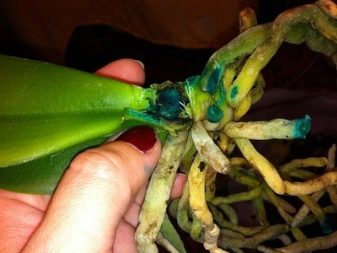

The plant can be frostbitten by improper watering during the cold period. Novice flower growers arrange steam baths for orchids with a shower, and then put them on the windowsill. Remaining moisture and currents of cold air create conditions for the core and leaves to begin to deteriorate. This is also helped by poor lighting with a lack of sunlight.
The source of trouble can be a wet substrate or soil that does not have time to dry out. Since it may be wrongly selected. Unsuitable bark is heavy and dense, poor air circulation occurs in it, and the water here does not have time to dry out.
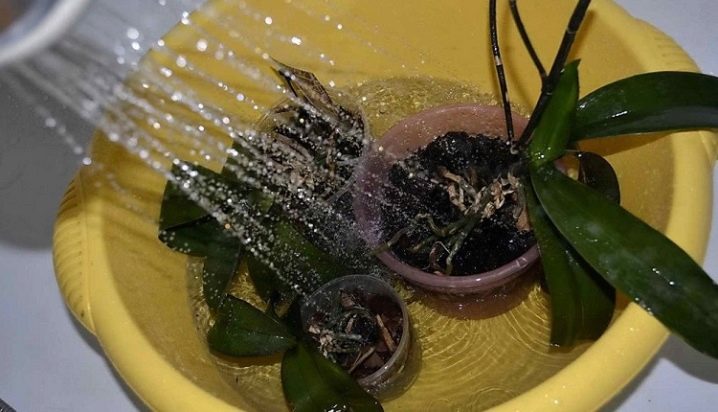
An excess of fertilizer can also be harmful, which creates a nitrogen oversaturation that leads to cracking. The flower gradually withers and rots in the presence of various parasites in it, as they skillfully hide. In this case, the hardest thing is to find out who exactly settled in the flowerpot. To find out the type of insects:
- a piece of apple or other fruit is left overnight in a flowerpot;
- the plant is immersed in a container of water.
The most common parasites include:
- ticks;
- click beetle;
- mealy worm.
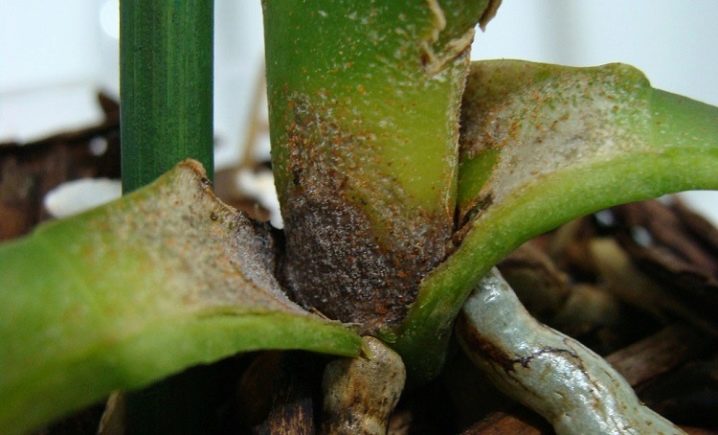
The clicker beetle can come from the street, it feeds on the root system. Therefore, when bringing a new plant into the house, keep it separately to check if there are harmful insects or not. An incorrect diagnosis can lead to confusion between parasite infestation with a fungal infection, anthracnose. With her, the plant dies very quickly if it has low immunity.
If such problems arise, the plant is isolated from others for quarantine, processed. The nearby plants are also examined.
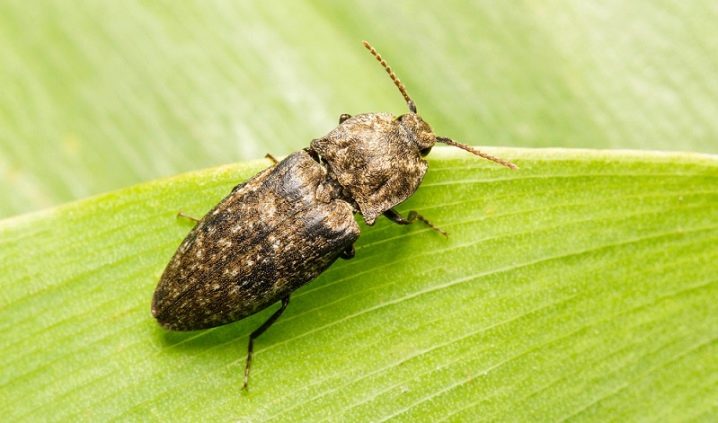
Step-by-step instructions for treating different types of rot
When buying an orchid, the owner immediately tries to find the maximum amount of care information. And the first thing that catches your eye: the natural habitat is tropical forests, where it is hot and humid. Therefore, in the future, they begin to water abundantly, confusing the concepts of moisture and excessive watering. Thus, they create an ideal environment for the development of pathogenic microorganisms, rot.
Important: Almost all members of the Orchid family are quite susceptible to various diseases. Rot is especially dangerous for them.
The most common are root rot, gray rot, neck rot.
Gray
Symptoms: the formation of dark areas with a fleecy bloom of gray on foliage, soil. The inflorescences, in turn, are covered with brown spots.
Reason: The appearance of rot usually occurs in conditions of high humidity and low temperatures. Also, over-frequent application of nitrogenous fertilizers can cause similar symptoms. Subsequently, the orchid loses its immunity to this disease.
Treatment:
- Transfer the diseased plant to another room with an optimal microclimate.
- Remove damaged areas of the flower.
- Treat phalaenopsis with an aqueous fungicide solution.
Prevention: with watering, use drugs that increase disease resistance. Do not forget about proper care.
Cattleya, phalaenopsis, cymbidiums most often suffer from gray rot.
We recommend watching a video about gray rot of an orchid and treating a flower from a disease:
Necks
Symptoms: the leaves fall off the neck of the stem, change color, acquiring a yellow tint. Outwardly, the disease no longer manifests itself, because the decay process takes place in the neck itself.
Reason: abundant moisture, prolonged nailing of roots in a wet substrate, critically low temperature in the room where the phalaenopsis is located.
Treatment: does not exist.
Prevention: competent plant care, increased immunity.
We recommend watching a video about orchid neck rot and treating a flower from a disease:
Root
Symptoms: the leaves begin to turn purple, a brown tint appears. The roots become soft, areas with rot are visible.
Reason: the room has high humidity and temperature.
Treatment:
- Revise the conditions of detention, create an optimal comfortable microclimate for Phalaenopsis.
- Treat the soil and flower with a 0.2% solution of Fundazol or Topsin. The procedure is carried out by immersing the pot in the solution.
- The number of procedures is at least 3 with an interval of 2 weeks.
Prevention: for planting orchids, use a calcined, disinfected substrate.
We recommend watching a video about orchid root rot and treating a flower from a disease:
Advice
To carry out successful resuscitation actions, you need to have the maximum amount of information, including being guided by the advice of people who have tried out certain methods in their own experience. Among the most valuable tips are the following.
In case of root rotting from below or rotting of the entire root system, the flower should not be immediately placed in moisture in order to restore the roots. The first priority is to fight the disease or parasites that have led to the detrimental result.
It is important to treat the affected area with fungicides and dry it well. In order for the orchid to receive moisture, it is necessary to place it above the water, keeping it in this position for about two weeks, after which it will be possible to germinate the roots in the water.
If there is a rotten area on the stem or root, it must be cured, for which dryness is a prerequisite
Once you manage to cope with the problem, you need to plant a flower and spray or wipe its leaves to give them moisture. Watering at this time will be undesirable. As soon as the bush is well rooted, spraying stops. You can add water in a standardized amount.
In the absence of rot on the root or stem, you can skip the process of abstaining from water germination and immediately use the moisture to or increase the root system.
In order for the resuscitation process to take place as quickly as possible, you need to give the orchid maximum light. In winter, fluorescent lamps are used for this, which can work 15 hours a day. The device should not emit heat so that the leaves do not overheat and dry out. In summer, there are no problems with light, the main thing here is to protect the culture from direct sunlight.
In the event that the lower leaf begins to turn yellow from the edge, this is normal, but if the process comes from the stem, then rot develops in it. In the first case, the leaf must be removed when it has turned yellow by more than half, in the second - at the first signs. Removal occurs by tearing off the sheet, and not cutting it off
It is important to carry out the procedure so that there are no remnants of the removed part. To help the plant, it is worth treating it with fungicides, which will protect the orchid and will be useful in treating the tear-off site.
These are basic tips to help speed up the healing process of your orchid and minimize the damage that has been done to your orchid in the past. Strict adherence to the recommendations and advice will give a chance not only to save the affected bush, but also to prevent any deviations in development thanks to the rich knowledge in this area.
For information on how to reanimate an orchid, see the next video.
The main causative agents of decay of the root system
Each fungal infection has its own pathogen - a fungus that causes rotting of the orchid root system.
Late blight, or late blight
It usually starts with wet spots on the outer part of the leaf or on the tuberidia, but often the disease starts in a different scenario - from the root system. Wet glassy areas appear, pressing on which, liquid flows out. The causative agents of infection are the fungi Phytophthora nicotianae, Phytophthora palmivora, Phytophthora cactorum, Phytophthora cinnamomi and others.
P. palmivora is the most common, the symptoms of which are very similar to bacteriosis caused by the bacteria Erwinia carotovora. That is why experienced orchivores advise treating plants with both antifungal agents and antibacterial agents, especially if it is not possible in laboratory conditions to determine the culprit of root rot for sure.
The P. cactorum fungus provokes black rot, which is almost indistinguishable from the lesion caused by Pythium ultimum.
Late blight is one of the most unpleasant diseases of both the aerial part and the root system of orchids, which occurs at temperatures above 25 degrees Celsius in a room with high air humidity. It develops almost rapidly, and within 2-3 days the plant can die if you miss it and do not take measures for treatment and rescue.
Rhizoctonia, or brown rot
It is caused by the soil fungus Rhizoctonia solani, which gets into the substrate with infected bark. It affects any type of orchid, but more often than others it is seen on miltonia, oncidium, wand, phalaenopsis, pafiopedillum.
It spreads through the root system extremely quickly. Just a few hours ago, the root was still white, but now it has turned brown. The affected areas are easily removed and expose the root thread.
Starting at the roots, rhizoctonia rises and higher on the stem, tuberidium and further to the very top of the plant. Very rarely, brown rot starts from the leaves, and then descends to the roots.
The fungus is activated at any temperature, the main thing for it is the high humidity of the air. It is especially often observed in winter, when orchids are dormant and abundantly moistened by their hosts.
Southern sclerocial rot
The disease is provoked by the fungus Sclerotium rolfsii, which manifests itself in orchids in very many ways. It appears on foliage, and on roots, and on pseudobulbs, and most often simultaneously affects the entire plant and destroys it without a chance of salvation. Possesses tremendous vitality that lasts for several years. It penetrates not only through the substrate, but also with irrigation water.
Mushroom spores germinate best in hot weather with a thermometer reading from 27 to 34 degrees above zero in a humid environment. However, even at lower temperatures during winter maintenance, when there is not enough light, the fungus also activates successfully. It can hit any orchid, but it is more often observed on wands and phalaenopsis.



